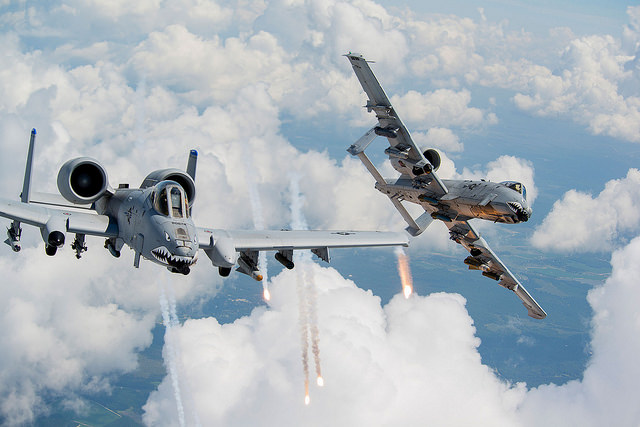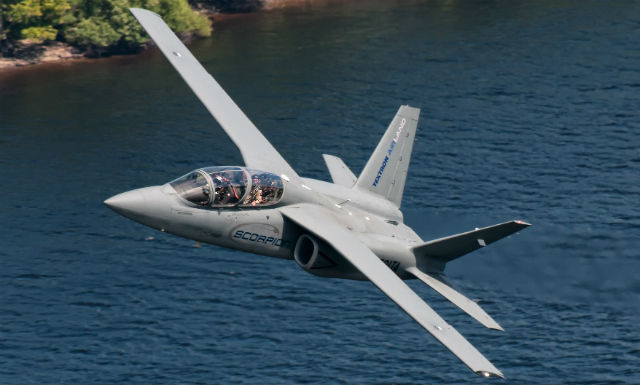The US Air Force has begun studying future close air support (CAS) aircraft to succeed the Fairchild Republic A-10 as the Pentagon evaluates the weaponry it needs for “prolonged operations” of one year or more.
The flying branch is looking at tactical air support platform alternatives for low-intensity “permissive conflict” like counterterrorism and regional stability operations, similar to the types of missions being conducted Iraq and Afghanistan today, where air superiority has been achieved and coalition aircraft can roam relatively freely in support of ground troops.
USAF officials say a portion of a "combat air force study” is dedicated to considering alternative CAS aircraft: everything from the Beechcraft AT-6 Wolverine, Sierra Nevada/Embraer A-29 Super Tucano, and the Textron AirLand Scorpion on the “low end” of the capability spectrum to more sophisticated clean-sheet attack aircraft or AT-X derivatives of the planned T-X next-generation trainer.
The study comes as the air force “re-phases” its retirement of the hardy A-10 "Warthog" that currently serves in the role. It has pushed back the fleet’s divestiture from this fiscal year to “between 2018 and 2022” at cost imposition of $3.4 billion.
Service officials admit that despite being an ideal close air support platform in high-end conflict with Russia, the long-delayed A-10 replacement, the Lockheed Martin F-35, will be too expensive to operate in the Warthog’s day-to-day role.
“[F-35] will be particularly capable in contested environments, like Russian doctrine where you would bring your air defences with you, because there will be a limited number of airplanes that can operate in that role,” USAF deputy chief of staff for strategic plans and requirements Lt Gen James Holmes tells a Senate Armed Services subcommittee panel on 8 March. “It would certainly be an expensive way to go after a permissive environment mission and we hope to not have to do that, so we will look at other options.”

US Air Force
In written testimony to the AirLand Subcommittee, the four testifying air force officials explain that the study will support a decision process sometime in the next five-year defence spending plan, which covers fiscal years 2018 to 2022. “This will serve to ensure that other current platforms and future systems meet future close air support requirements,” the prepared statement says.
The A-10 was introduced in 1975 and upgraded to the more capable A-10C configuration in 2007. Its backers in Congress have consistently protected it from the air force’s budget axe.
Holmes told reporters after the hearing that the air force needs to figure out if it needs an entirely new attack platform or a more basic “off-the-shelf” option like the AT-6, A-29 or Scorpion before pushing forward with a new acquisition programme.

Textron AirLand
“There are some very low-end airplanes out there, like the A-29 that we’re partnering with for Afghanistan and training their crews in,” Holmes says. “The question is, is it enough? We know that an F-35 is too much, but is an A-29 enough for the mission set we need to do or do we need something in-between? Is there a derivative of our T-X platform that could do some range of lower-cost missions?”
Holmes cautions that the T-X Advanced Pilot Trainer programme hasn’t even entered development and still many years away from delivering the 350 training aircraft required to replace the Northrop T-38. An AT-X derivative would need to wait until the original trainer requirement is satisfied, and T-X initial operational capability isn’t due until 2024.
“I don’t want to add requirements to that, which would make it too expensive,” Holmes says, noting that the air force will likely need a new attack aircraft sooner.
“One of the hardest things to do in the [US Defense Department] budget process is to spend $1 this year to save $10 later because you can’t scrape up the $1 this year to do it because of other pressing needs,” he says. “You make that trade of paying more to fly an F-16 vice a lower capability airplane.”
The air force has been considering new ways to use F-15s and F-16s in the CAS role through upgrades and new tactics. DARPA has been experimenting with new tablet computer-based software that makes it easier for "JTAC" targeting specialists on the ground to call in air fire with greater accuracy and less collateral damage, under a Raytheon-led project called persistent close air support (PCAS). That programme demonstrated full functionality with an A-10C in May 2015.
Source: FlightGlobal.com



















